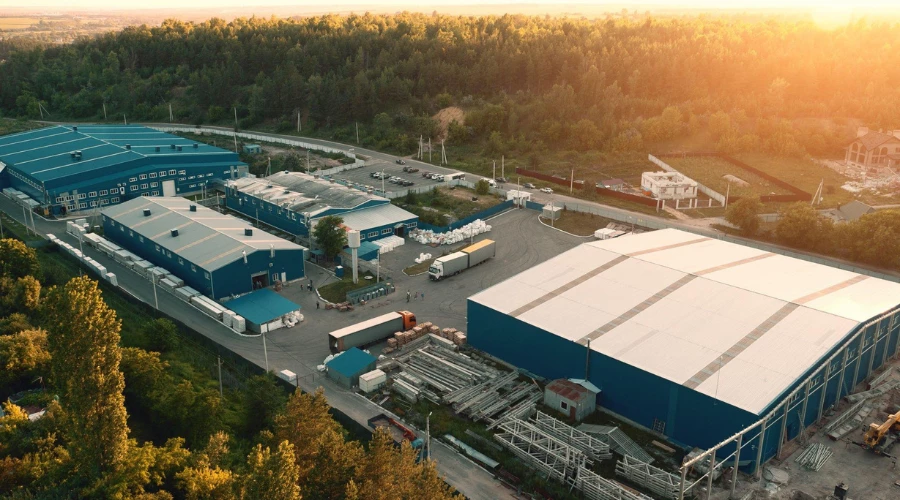
Warehouses and industrial land are experiencing transformative changes as they adjust to the demands of the contemporary era. In an increasingly digital world where e-commerce reigns supreme and efficient supply chains are essential, warehouses have emerged as vital components of the global market. From multistorey warehouses to robotics and automation, the future of warehousing is evolving rapidly.
In recent years, the industrial and logistics sector has witnessed an unparalleled surge in growth. This remarkable acceleration can be attributed to various factors, such as the surging demand for e-commerce and delivery services, disruptions in supply chains, and the ever-evolving needs of consumers. The pandemic has further amplified these trends, leading to a surge in investment and demand for industrial properties. As Jeff Miller, Senior Vice President at Oxford Properties Group, states, "The industrial and logistics asset class has been on an amazing run." The sector has become a nearly half-trillion-dollar global market, and the investment activity shows no signs of slowing down.
As the demand for industrial land continues its upward trajectory, the availability of such land is progressively diminishing, leading to a scarcity in supply. This scarcity has prompted industry players to explore creative solutions to meet the growing needs of the market. One such solution is the emergence of multistorey warehouses, a concept popular in Asian markets and now gaining traction in North America. With limited available land, building vertically allows for increased warehouse capacity. Additionally, some warehouses are turning to robotics and automation to address labor and efficiency shortages. These technological advancements are transforming warehouses into fully automated facilities, improving productivity and operational efficiency.
The growth of the warehousing industry is driven by a focus on meeting the unique needs of individual markets and populations. Data analysis plays a crucial role in determining market demand, size, and purchasing patterns. This information informs key decisions regarding warehouse design, location, and operation. For instance, the increasing importance of last-mile delivery and micro-fulfillment centres has led to a shift in warehouse strategies. Warehouses are now strategically located to ensure faster delivery times and cater to modern consumer cravings for quick and efficient service. The increasing pressure to meet these demands is compelling companies to adopt a more creative and innovative approach.
Moving forward, numerous trends are anticipated to shape the future of the warehousing industry. Multistorey warehouses and micro-fulfillment centres will continue to gain popularity as warehouse owners seek to optimize their use of limited space. The integration of robotics and automation will further enhance efficiency and productivity within warehouses. Retailers, recognizing the importance of warehouses as part of their multichannel offerings, will redefine the role of these facilities in their operations. Diversified investment in the sector will also remain a hot ticket, as warehouses continue to play a vital role in the global supply chain.
Warehousing companies are increasingly focused on optimizing delivery time while maintaining the quality of their services. This is achieved through the implementation of cutting-edge technology, which enhances delivery networks and streamlines warehouse management processes. By optimizing batching, handling, and picking processes, warehouses can meet customer demand more efficiently. Additionally, the growing area of reverse logistics requires warehouses to acquire, store, and re-ship orders efficiently. To address this, companies are adopting agile models that offer greater control and flexibility in local storage houses.
Logistics parks have emerged as a key solution for companies looking to expand their operations while maintaining control over their supply chain. These integrated parks provide access to technology, infrastructure, and key resources necessary for efficient warehouse management. Companies like IndoSpace are leading the way in developing logistics parks that empower businesses and enable seamless growth. By optimizing location, technology, infrastructure, and connectivity, these parks offer a comprehensive solution for companies seeking integrated warehousing facilities.
The adoption of comprehensive warehouse management systems is proving to be highly beneficial for enterprises. These systems provide real-time data and insights into warehouse processes, assets, and performance. By leveraging technologies such as smart tracking, IoT devices, and AI-enabled processing, employees can increase productivity and ensure faster delivery times. As the industry moves towards greater automation, integrated warehouse management systems are becoming indispensable for optimizing warehouse operations and overall supply chain management.
Large enterprises in the e-commerce, B2B manufacturing, and retail sectors are increasingly turning to short-term rental warehouses to manage seasonal demand effectively. Warehouses for lease provide the flexibility needed to handle fluctuations in demand without compromising on quality. Region-specific warehouse models are also gaining popularity as they offer local storage options to meet specific project requirements. By leveraging these warehouses for lease, companies can optimize delivery times and cater to local demand more efficiently.
The warehousing industry is undergoing a shift towards greener practices to reduce reliance on traditional energy sources and create sustainable competencies. Warehouses are investing in energy-efficient equipment and infrastructure, optimizing power utilization, and developing warehouses with recyclability in mind. By adopting eco-friendly practices, warehouses can reduce operational costs and contribute to a more sustainable supply chain model.
To keep pace with the demands of the modern world, the warehousing industry is undergoing rapid evolution. From multistorey warehouses and robotics to integrated warehouse management systems and sustainable practices, warehouses are embracing innovation to optimize efficiency and meet customer expectations. As companies continue to adapt and innovate in response to shifting market dynamics, the future of the warehousing industry holds promising possibilities. As we look ahead, warehouses will remain critical components of the global supply chain, bringing goods closer and faster to the communities that depend on them.
In this ever-evolving world of warehouse and land, 13SQFT.com will help you find the best warehouse/ land according to your needs and requirements.
POSTED BY
Ishika Adhana
Digital Marketing Executive